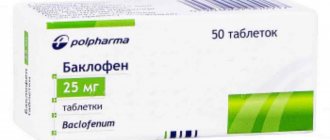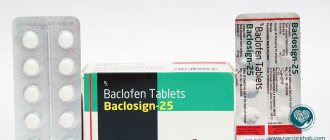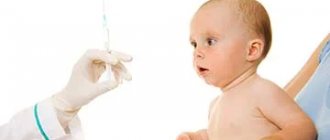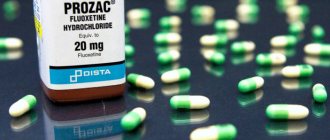Some drug addicts rely on pharmaceutical drugs, which are always available for sale and attract less attention from law enforcement agencies. Many drug addicts are even of the opinion that narcotic drugs are not so dangerous to the body.
Read further:
- Brief information about the drug
- Gabapentin is a pharmaceutical drug
- Dangerous combinations of Gabapentin
- Side effects
- Signs of using the pharmaceutical drug Gabapentin
- Withdrawal syndrome
- Consequences of using Gabapentin
- Gabapentin overdose - first aid
- Treatment of Gabapentin Addiction
Today we’ll talk about the fairly well-known pharmaceutical drug Gabapentin, learn about its narcotic effect, signs and consequences of use, symptoms of overdose and how addiction to this potent drug is treated.
Brief information about the drug
| Gabapentin - pharmacological properties | A potent anticonvulsant with a pronounced analgesic effect |
| Dosage form | Capsules, tablets |
| Methods of administration | Orally |
| Application in medical practice | Treatment of seizures, epilepsy, neuropathic pain, migraine, anxiety disorders. Dispensed by prescription. |
| Time of action | 5-7 hours |
| Compound | 300 mg of active ingredient - gabapentin, calcium stearate, sodium carboxymethyl starch, microcrystalline cellulose |
Gabapentin is a pharmaceutical drug
Based on the principle of action, the pharmaceutical drug Gabapentin is compared with the effects of the drug Lyrica. When consumed in an increased dosage, pleasure centers are disinhibited, resulting in a euphoric effect, a surge of positive emotions and other pleasant sensations. But, if you overdo the dosage a little, hallucinations and delusional states occur.
Due to regular use of Gabapentin, severe dependence and tolerance develops, against the background of which the addict constantly has to increase the usual dosage to obtain euphoric sensations.
The effect after oral administration occurs within 20-30 minutes. The narcotic effect of the drug lasts 5-12 hours. However, with regular use of pharmaceutical drugs, the period of pleasure is quickly shortened.
Pharmacological properties of the drug Gabapentin
Gabapentin is structurally similar to GABA, however, its mechanism of action differs from other drugs that interact with GABA receptors (valproate, barbiturates, benzodiazepines, GABA transaminase inhibitors, GABA uptake inhibitors, GABA agonists and GABA prodrugs). At therapeutic concentrations, it does not bind to the following receptors: GABA A and B, benzodiazepine, glutamate, glycine and N-methyl-d-aspartate. In vitro studies of labeled gabapentin have identified new peptide receptors in rat brain tissue, including the neocortex and hippocampus, which may mediate the anticonvulsant activity of gabapentin and its derivatives (the structure and function of gabapentin receptors are not fully understood). Rapidly absorbed when taken orally. Bioavailability is not proportional to the dose - with increasing dose it decreases and is: at a dose of 300 mg - 60%, at 1600 mg - 30%, respectively. Absolute bioavailability - 60% (capsules). Food, including those high in fat, does not affect the pharmacokinetics of the drug. The maximum concentration in blood plasma is achieved 2–4 hours after oral administration. Plasma concentrations are dose proportional. The maximum plasma concentration is 4.02 mcg/ml when used at a dose of 300 mg every 8 hours and 5.5 mcg/ml when used at a dose of 400 mg. Passes through the BBB and enters breast milk. Distribution volume - 57.7 l. In patients with epilepsy, the minimum concentration of gabapentin in the CSF is approximately 20% of that in plasma. The binding to plasma proteins is very weak (less than 5%). Practically not metabolized. Excreted by the kidneys. Removal from blood plasma has a linear relationship. The half-life averages 5-7 hours, does not depend on the dose (at a dose of 300 mg - 5.2 hours, at a dose of 400 mg - 6.1 hours). The elimination rate constant, plasma clearance, and renal clearance of gabapentin are directly proportional to creatinine clearance. Removed by hemodialysis. The clearance of gabapentin from blood plasma is reduced in elderly people and patients with impaired renal function; the half-life for creatinine clearance less than 30 ml/min is 52 hours. Pharmacokinetics do not change with repeated use.
Dangerous combinations of Gabapentin
Many drug addicts take Gabapentin in combination with alcohol or energy drinks, which enhance the effect of the drug. And some, in pursuit of unrealistic feelings of euphoria, take it simultaneously with other drugs. Such experiments can cost human life.
| Gabapentin + alcohol | Confusion, swelling of the face and limbs, muscle cramps, pain throughout the body. Coma and sudden death may occur |
| + Lyrics | There is an increase in adverse reactions of two drugs |
| + Morphine | Drowsiness, respiratory depression, lethargy |
Purpose
Taking into account the therapeutic effect of the main component, Gabapentin is prescribed by veterinarians to cats:
- for epileptic seizures;
- neuropathic pain (including those accompanying inflammatory processes - for example, in the genitourinary organs,
- oncological diseases to relieve pain;
- for chronic arthritis and other joint diseases;
- hyperesthesia (increased sensitivity to irritating factors);
- under stress associated with long trips, change of home or long-term absence of the owner, hygienic and medical manipulations, etc.;
- in the postoperative period.
For elderly animals, the medicine is prescribed to prevent the development of arthritis and other degenerative changes in the body, accompanied by painful sensations.
Important!
The positive property of the drug, which determines its popularity, is its rapid action. Without binding to proteins, gabapentin spreads through the blood vessels to all tissues and organs within half an hour after administration and begins an active therapeutic effect.
Signs of using the pharmaceutical drug Gabapentin
You can suspect the use of Gabapentin as a pharmaceutical drug based on characteristic signs:
- sleep disturbance;
- the person becomes overly sociable and talkative;
- there is a lack of coordination of movements, slurred speech, unsteady gait;
- attacks of aggression may occur for no reason;
- depressive disorders;
- hallucinations, delusional states.
Some drug addicts who take this drug experience suicidal thoughts.
How to give, dosage
Capsules or tablets are given to the cat orally. The tablets can be crushed, diluted with water and given to the cat from a syringe. Do the same with the contents of the capsules.
The dose for eliminating cramps is higher than for pain relief. According to the instructions, as an anticonvulsant, the drug should be taken every 8 hours at the rate of 10-20 mg per kilogram of the cat’s weight. If the medication is used as an analgesic, then the recommended dose is 5-10 mg per 1 kg of animal weight.
The medication should not be discontinued on one day, but over the course of a week, gradually reducing the dosage.
Withdrawal syndrome
Withdrawal syndrome appears one day after the last dose of Gabapentin and can last up to 7-10 days. Withdrawal from this pharmaceutical drug is quite pronounced and is accompanied by painful physical and severe mental manifestations. The symptoms have much in common with the withdrawal symptoms characteristic of opium addicts.
Signs of withdrawal syndrome:
- unbearable joint and muscle pain;
- diarrhea;
- heart rhythm disturbance;
- increased sweating;
- a sharp increase in blood pressure;
- headache;
- loss of appetite;
- sleep disturbance;
- irritability, anxiety, depression.
Description and scope
To understand the difference between Gabapentin and Pregabalin, you must first know what each is intended for. Both are classified as antiepileptic drugs and are often prescribed to prevent seizures in patients with epilepsy.
Gabapentin (Neurontin) has a similar structure to aminobutyric acid, but unlike it, its mechanism of action on GABA receptors has not yet been fully elucidated. It is used not only to treat mixed and focal seizures in epilepsy, but also for other health problems. Such as:
- neuropathic pain;
- anxiety disorders;
- bipolar disorder;
- infantile and pendulum nystagmus;
- hormonal hot flashes;
- multiple sclerosis;
- alcohol withdrawal symptom;
- skin itching of various origins;
- restless legs syndrome;
- orthostatic and essential tremor.
Pregabalin has a rapid action, which gives it a clear advantage over similar drugs. Has a pronounced anti-anxiety effect. It is used to treat the following conditions:
- chronic pain due to spinal cord injuries and fibromyalgia;
- generalized anxiety disorder;
- neuropathic pain;
- epilepsy.
The main difference between Pregabalin and Gabapentin is that the spectrum of use of the second drug is much wider.
Reference! It is strictly forbidden to take both drugs simultaneously with alcohol, as it can enhance their effectiveness several times, which causes severe intoxication.
Consequences of using Gabapentin
Recreational use of Gabapentin causes serious health consequences. This potent pharmaceutical drug destroys the central nervous system, causes severe poisoning of the body, and reduces immunity.
Common pathologies caused by uncontrolled use of Gabapentin:
- diseases of the gastrointestinal tract;
- disruption of the cardiovascular system;
- urinary tract infections;
- inflammatory diseases of the respiratory organs;
- dermatological pathologies associated with allergic reactions to the drug;
- kidney disease, leading to severe tissue swelling;
- mental disorders, chronic depression;
- convulsions;
- paranoia;
- erectile dysfunction in men.
Gabapentin, taken as a narcotic substance, significantly shortens a person's life span. Drug addicts need qualified help. The best solution is to go to a drug treatment clinic, where you can undergo comprehensive treatment for drug addiction under the supervision of experienced specialists.
Special instructions for the use of Gabapentin
The drug should be discontinued or replaced with an alternative drug gradually, reducing the dose over at least 1 week. Abrupt cessation of antiepileptic drug therapy in patients with epilepsy can provoke status epilepticus. Ineffective for the treatment of absence seizures. During pregnancy, it is used only if the expected benefit to the mother justifies the possible risk to the fetus (possible slowdown in fetal growth if the therapeutic dose of 3600 mg is exceeded in terms of mg/m2). Excreted in breast milk. Its effect on breastfed newborns is unknown, so it should only be used during breastfeeding if the benefit to the mother clearly outweighs the risk to the baby. During the treatment period, it is necessary to refrain from potentially dangerous activities that require increased concentration and speed of psychomotor reactions. The safety and effectiveness of gabapentin in children under 3 years of age as adjunctive therapy for epilepsy and in children under 12 years of age as monotherapy have not been established. The safety and effectiveness of treatment for neuropathic pain in patients under 18 years of age have not been established. If drowsiness, ataxia, dizziness, increased fatigue, nausea and/or vomiting, weight gain appear in adults, and drowsiness, hyperkinesia and hostility in children, treatment should be discontinued.
Gabapentin overdose - first aid
Uncontrolled use of Gabapentin often leads to overdose. This is a very dangerous condition with a direct threat to life, characterized by severe intoxication of the body.
Signs of a pharmaceutical drug overdose:
- clouding of consciousness;
- severe drowsiness;
- slurred speech;
- dizziness;
- double vision;
- lethargy;
- vomit;
- diarrhea;
- labored breathing;
- coma.
If symptoms of overdose are detected in a person who has taken Gabapentin in an increased dosage or in combination with other toxic substances that enhance the effect of the drug, it is necessary to call an ambulance.
Host reviews
Valentina Petrenko, 45 years old:
“As prescribed by the veterinarian, I gave my cat Gabapentin before visiting the veterinary clinic to make her less nervous. The animal almost immediately showed side effects: lethargy, drowsiness, and lack of appetite. I learned too late that this drug is contraindicated for kidney pathologies. And she has chronic renal failure, so this reaction occurred. It took a long time to restore the cat’s health.”
Vladimir Korolev, 35 years old:
“My cat has chronic arthritis and the vet prescribed Gabapentin for pain relief. The medicine was administered starting with a minimum dosage, gradually increasing it. The course of treatment lasted a month, and the animal’s condition really improved during this time. No side effects were observed, except for slight drowsiness. I also stopped taking the medication gradually, over the course of a week. The doctor warned that it is impossible to suddenly stop taking the drug.”
Treatment of Gabapentin Addiction
Modern drug treatment centers provide comprehensive medical and rehabilitation treatment for addiction to Gabapentin and other pharmaceutical drugs. The course of therapeutic therapy consists of several stages:
- Hemodialysis, infusion therapy (detox). In case of acute poisoning with the drug, resuscitation measures are carried out.
- To relieve withdrawal symptoms during the abstinence period, symptomatic treatment is indicated.
- Rehabilitation therapy. Restoring the normal functioning of vital organs and systems. Increasing the body's defenses.
- Psychological help. Psychotherapy sessions. Motivation for a sober, drug-free life.
- Rehabilitation, restoration of social skills and trusting relationships with family.
A comprehensive Gabapentin drug addiction treatment program is showing positive results. Hospitalization to an inpatient drug treatment clinic is carried out routinely by prior arrangement, as well as urgently in case of poisoning with a pharmaceutical drug or in case of severe withdrawal symptoms during the period of abrupt drug withdrawal.
Treatment of Gabapentin addiction and other forms of drug addiction is carried out anonymously on a voluntary basis. The patient must give written consent to the full course of medical and rehabilitation therapy. More detailed information on all questions of interest can be obtained by telephone. Call us! We will help everyone!
Use of the drug Gabapentin
Inside, regardless of meals or with food. Epilepsy Adults and children over 12 years of age: initial dose - 300 mg 3 times a day on the first day, effective dose - 900-3600 mg / day. The maximum daily dose is 3600 mg (in 3 equal doses). The maximum interval between doses when prescribing the drug 3 times a day should not exceed 12 hours. It is possible to prescribe according to the following scheme (dose selection stage): at a dose of 900 mg, on the 1st day - 300 mg 1 time per day, on the 2nd day 1st day - 300 mg 2 times a day, on the 3rd day - 300 mg 3 times a day; at a dose of 1200 mg - 400 mg 1 time per day, 400 mg 2 times per day, 400 mg 3 times per day, respectively. Children aged 3–12 years: effective dose – 25–35 mg/kg/day in 3 divided doses. The dose can be titrated to an effective dose over 3 days: 10 mg/kg/day on the 1st day, 20 mg/kg/day on the 2nd and 30 mg/kg/day on the 3rd. In a long-term clinical study, the drug was well tolerated in doses of up to 40–50 mg/kg/day. Neuropathic pain in adults The initial dose is 300 mg 3 times a day, if necessary, the dose is gradually increased to a maximum of 3600 mg/day. Patients with impaired renal function: with creatinine clearance more than 60 ml/min - 400 mg 3 times a day; with creatinine clearance from 30 to 60 ml/min - 300 mg 2 times a day; with creatinine clearance from 15 to 30 ml/min - 300 mg 1 time per day; with creatinine clearance less than 15 ml/min - 300 mg every other day. For patients on hemodialysis who have not previously received gabapentin, it is recommended to prescribe a loading dose of 300–400 mg, and then 200–300 mg every 4 hours of hemodialysis.
Gabapentin or Pregabalin: Differences in Side Effects
Due to the slightly different effects on the body of the main active ingredient of these drugs, their side effects on the body are also very different.
The most common negative consequences of taking Gabapentin include:
- tremor;
- nystagmus;
- peripheral edema;
- ataxia;
- drowsiness;
- fatigue;
- dizziness;
- sometimes erectile dysfunction and loss of libido.
Also, while taking this anticonvulsant drug, dysfunction of almost all body systems is possible.
Pregabalin has much fewer side effects:
- ataxia;
- headache;
- drowsiness;
- dizziness.
Thus, when studying which is more dangerous, Pregabalin or Gabapentin, the comparison showed that the first drug has much fewer negative effects on human health.
Reference! It is important to know that since 2021, Pregabalin has been included in the register of potent drugs and is sold only by prescription.
addictive
Due to the same effect on the nervous system, both Pregabalin and Gabapentin, when used in large doses, can cause rapid, persistent dependence.
Reference! According to statistical data in Russia, the main population abusing these medications are people aged 20-35 years.
When taking Pregabalin or Gabapentin for pharmacological purposes, dependence on them is extremely rare. But over time, the body begins to break down and remove them faster, which provokes a person to increase the dosage . This helps to restore the previous effect of these drugs, but leads to addiction . To prevent this, you need to contact your doctor to adjust your therapy.









